7 Best Lat Pulldown Variations (with Pictures!)
For building a wide and powerful back, the lat pulldown is inarguably one of the best candidate exercises.
As is the case with most machine-based movements however, the lat pulldown has several variations that change the emphasis of the exercise and the sort of benefits it offers.
Depending on which specific pull muscle you wish to emphasize, exercises like the neutral grip pulldown or underhand pulldown may be your best bet.
Alternatively, if you wish to create a greater focus on your lats, movements like the wide grip pulldown and standing pushdown are better.
What are Lat Pulldowns?
Lat pulldowns are a type of compound open-chain cable machine exercise performed so as to train the muscles of the back and biceps.
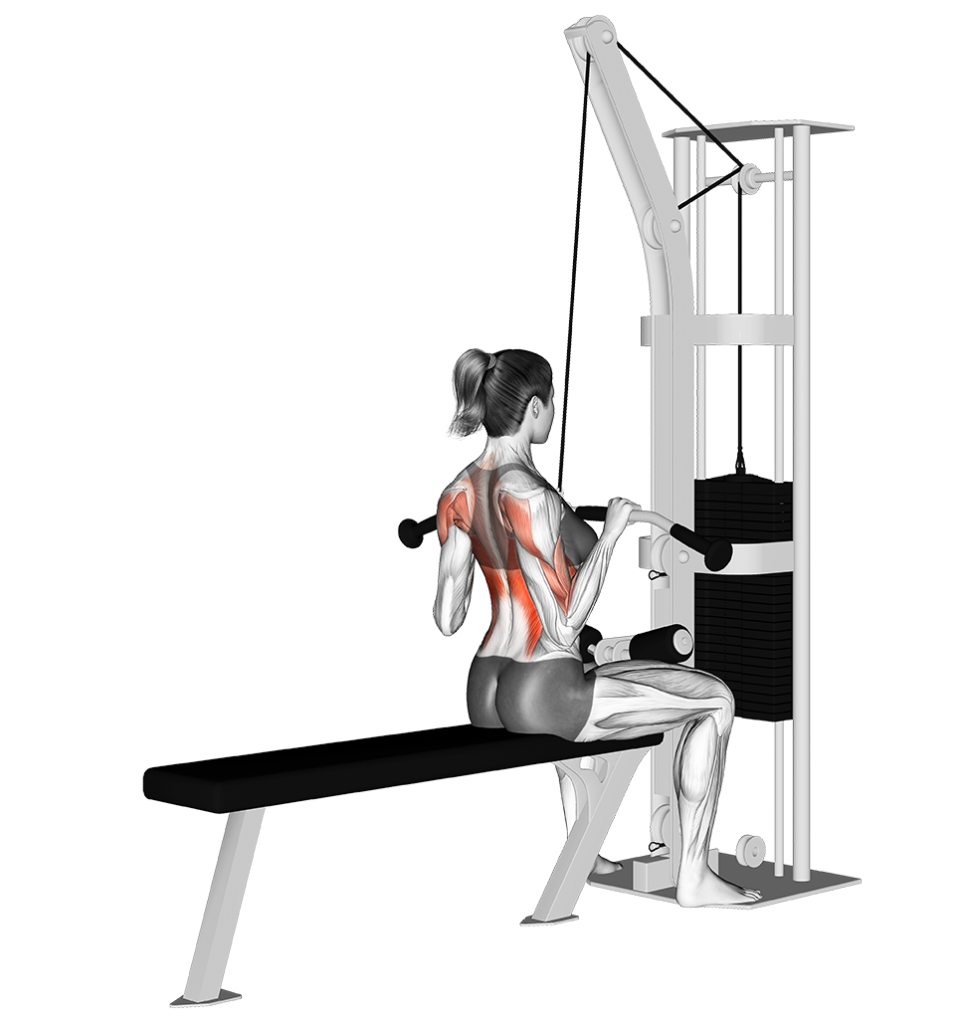
Classified as a vertical pull, they are used as either the primary movement in a pull day workout or as an accessory to heavier exercises like the barbell row or deadlift.
The majority of lat pulldown variations simply change the orientation and position of the lifter’s hands along the pulldown bar.
This, in turn, changes which specific muscles are emphasized by the exercise. Generally, a wider or pronated grip equates to more latissimus dorsi work. Likewise, a narrower supinated one equates to more mid-back and bicep work.
Lat Pulldown Variations
1. The Conventional Lat Pulldown
Conventional lat pulldowns are simply the standard form of lat pulldown, featuring a shoulder-width hand placement and a pronated grip.
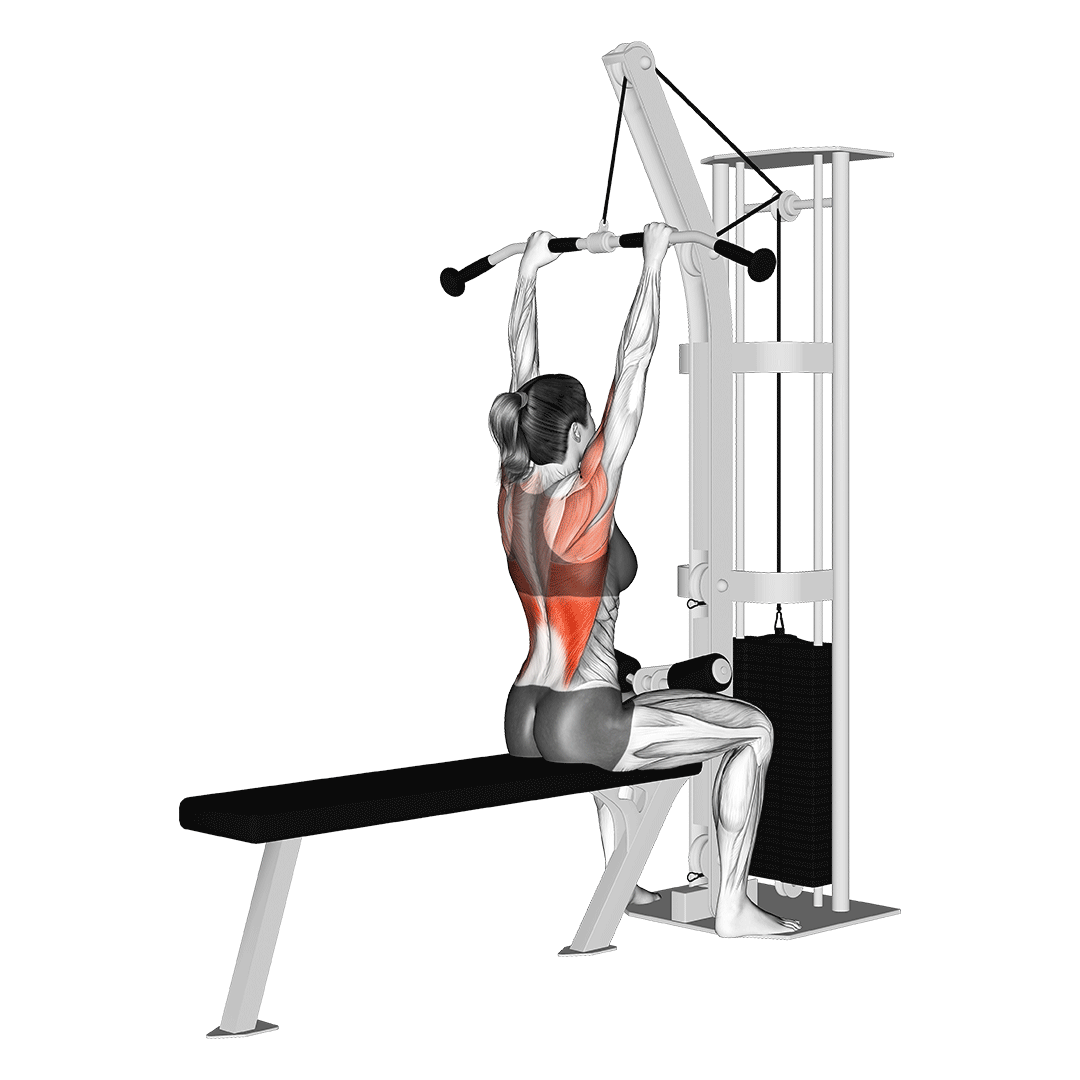
The conventional lat pulldown is most often included into a workout so as to equally distribute development among the muscles of the mid-back, often for moderate volume and resistance.
Like most other variations, the regular lat pulldown makes marked use of elbow flexion and scapular retraction in order to draw the bar vertically downwards. This can be further intensified by leaning the torso slightly back, maximizing recruitment of the lats.
Back Muscles Worked
The conventional lat pulldown will focus the most on the outer section of the latissimus dorsi. This is in addition to recruitment of the trapezius, infraspinatus, the teres muscles and the posterior deltoid head.
Furthermore, the muscles of the brachioradialis, brachialis and biceps are all worked to a lesser degree as well.
Benefits as a Lat Pulldown Variation
Traditional lat pulldowns are the standard version of the exercise, meaning that it is best to first master them prior to attempting more complex variations.
Conveniently, this also meshes quite well with its capacity to act as a general all-around back builder, targeting nearly every muscle found throughout the back in a low-impact and accessible manner.
In particular, lat pulldowns excel when performed alongside heavy exercises that target the more underutilized sections of the back. A few good combinations would be the lat pulldown and the barbell shrug, with the biceps curl or with the Yates row.
How-to:
To perform a repetition of the conventional lat pulldown, the lifter will seat themselves within the lat pulldown machine, raising their hands and placing them slightly wider than shoulder-width apart along the bar, palms down.
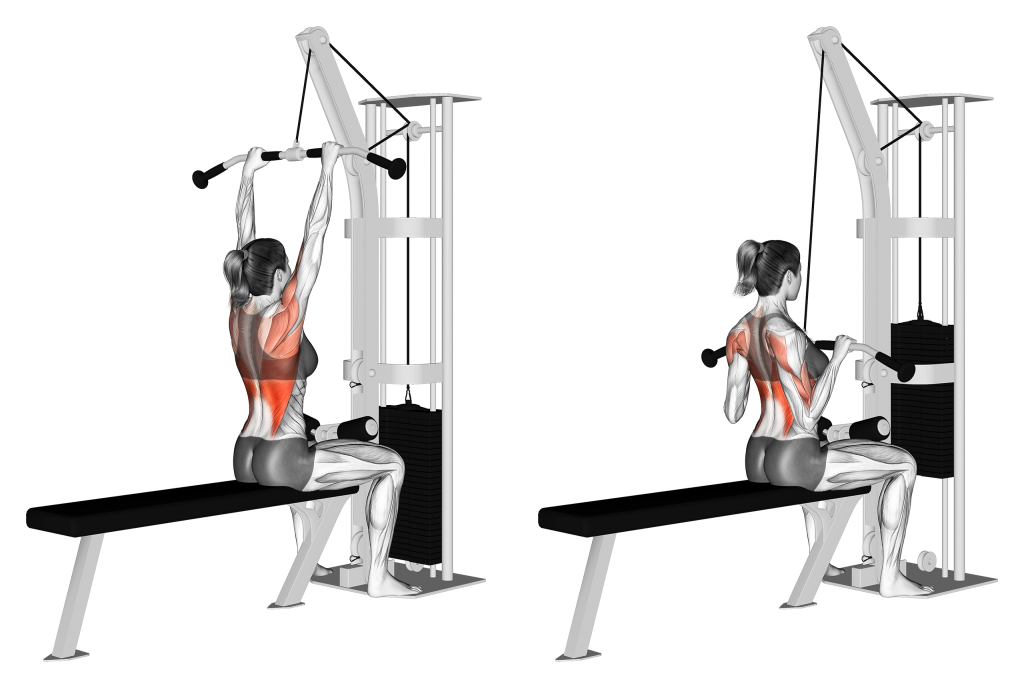
Keeping the chest pushed out and the torso upright, the lifter will then pull the bar downwards, contracting their lats and angling their elbows so they are drawn behind the torso.
As the bar moves beneath the chin, the lifter will squeeze their scapula together before allowing the resistance to draw their arms back upwards. Once the bar is back overhead, the repetition is considered to be complete.
2. The Close Grip Lat Pulldown
As its name implies, the close grip lat pulldown is simply a conventional lat pulldown performed with the hands set significantly closer together.
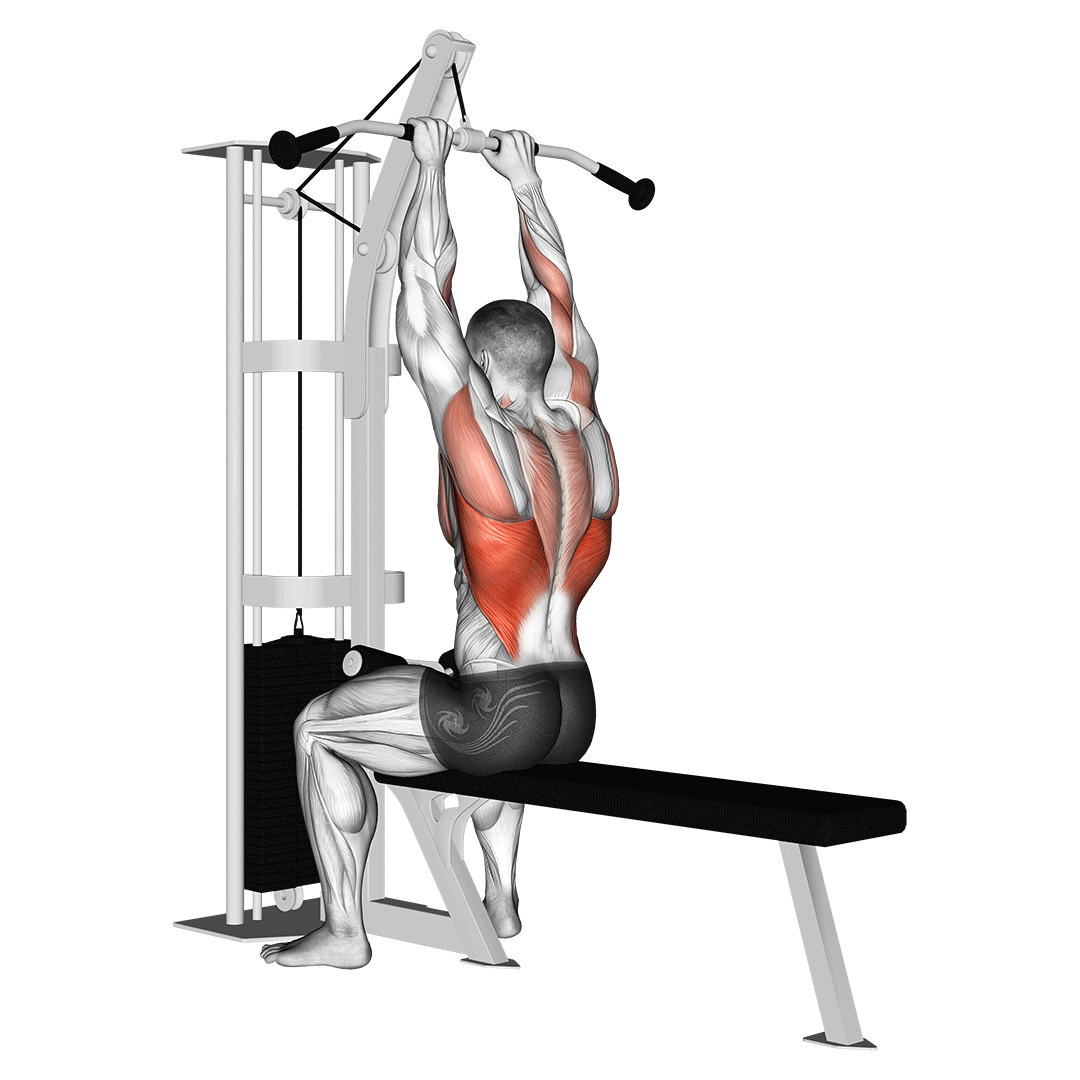
Shifting the position of the hands in this manner creates greater emphasis on the mid-back muscles - especially the lats, of which will be responsible for the majority of pulling power as the arms are in a disadvantageous position.
Apart from a closer grip and shift in emphasis, the close grip lat pulldown is otherwise mechanically the same, featuring marked use of elbow flexion and scapular retraction.
Unlike its conventional cousin, the close grip variant should be performed with the torso entirely vertical. Avoid tilting the body backwards when performing this variation.
Back Muscles Worked
The close grip lat pulldown isolates the latissimus dorsi and lower trapezius to a greater degree.
Of course, this is in addition to the teres muscles, middle trapezius, posterior deltoid head, rhomboids and infraspinatus.
Benefits as a Lat Pulldown Variation
Performing lat pulldowns with a close grip is ideal for working the muscles of the mid-back - of which are often undertrained despite their use in exercises like the barbell row and chin-up.
Muscular emphasis aside, a closer grip also means that the arms need to travel a longer distance prior to drawing the bar beneath the chin. This equates to a longer time under tension, improving the quality of each repetition.
How-to:
To perform a repetition of the lat pulldown with a close grip, the lifter will set their hands at shoulder-width distance or closer along the bar using a double overhand grip.
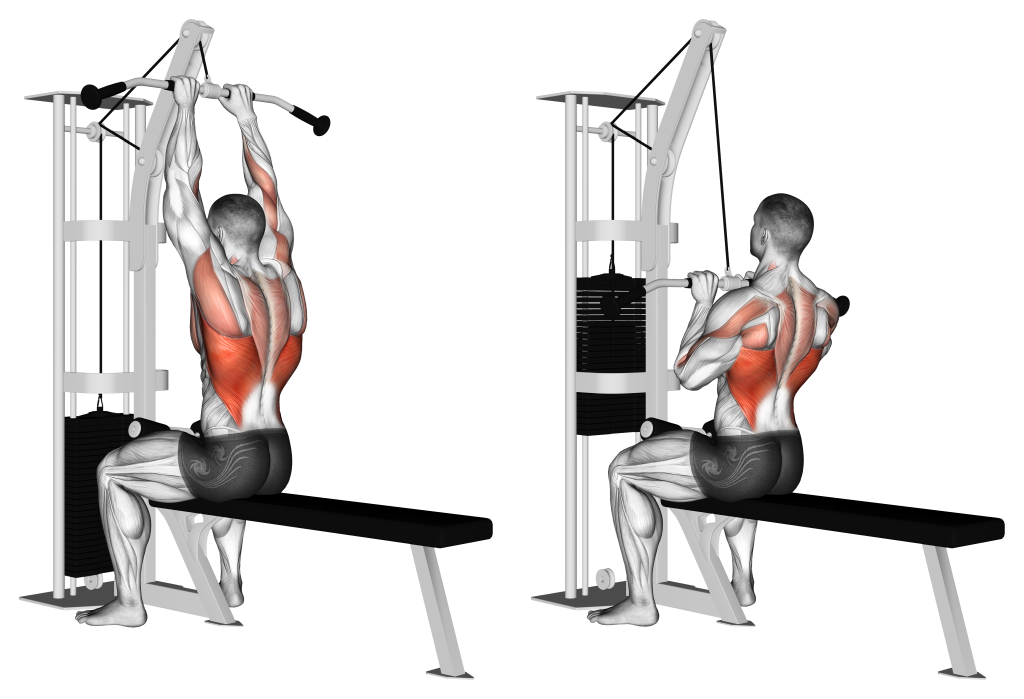
Ensuring the core is braced and the torso vertical, the lifter then depresses their scapula and draws their elbows towards each other behind the torso. This pull should be followed until the bar is beneath the chin and the elbows are parallel to the sides of the torso.
To complete the repetition, the lifter then reverses the motion, extending their elbows and allowing the bar to pull their arms back upwards.
3. The Wide Grip Lat Pulldown
As a direct counterpart to the close grip pulldown, the wide grip lat pulldown instead features a significantly wider than shoulder-width hand position. With a wider grip comes greater recruitment of the outer section of the latissimus dorsi, as well as less involvement of the elbow flexor muscles of the arms.
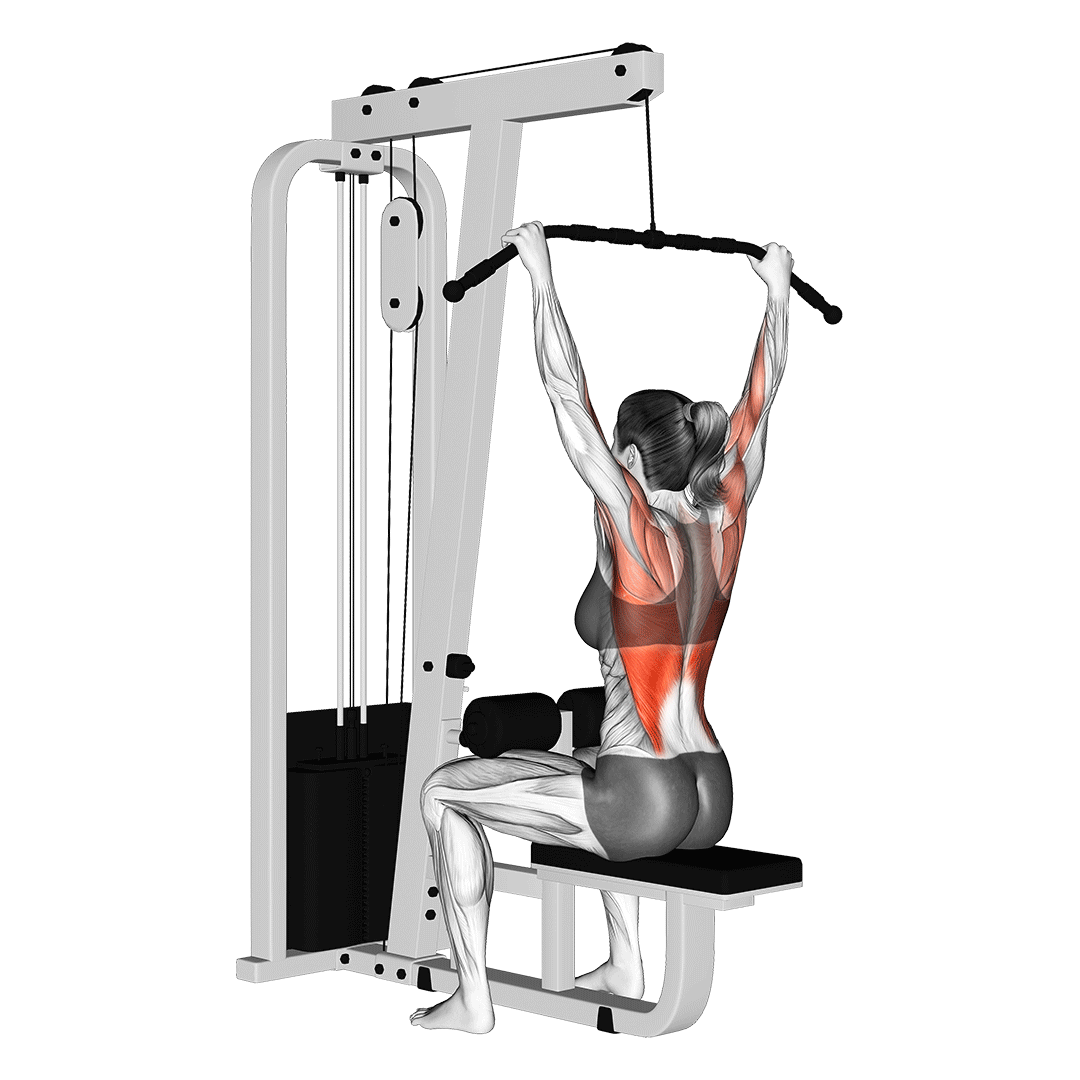
Apart from greater emphasis on the lats, the wide grip lat pulldown is also used as a technical variation due to its shorter range of motion and capacity to correct issues during certain portions of the conventional pulldown.
Wide grip lat pulldowns are also occasionally referred to as snatch grip pulldowns, as both terms refer to a wider than shoulder-width hand placement.
Back Muscles Worked
The wide grip variation of the lat pulldown emphasizes the upper section of the latissimus dorsi the most, eliminating usage of the biceps, brachioradialis or brachialis muscles.
In addition to the lats, this particular variant will also work the posterior deltoids, the rotator cuff muscles and the upper trapezius to a somewhat lesser extent.
Benefits as a Lat Pulldown Variation
The wide grip lat pulldown’s defining variation is its capacity to build a wider back through targeted recruitment of the upper section of the latissimus dorsi muscles.
Hypertrophy aside, the wide grip variant is also occasionally used for correcting sticking points and instability of the conventional lat pulldown. This, combined with its greater loading capacity on account of a shorter range of motion, make it a favorite among weightlifting athletes as a technique development tool.
How-to:
To perform a repetition of the wide grip lat pulldown, the lifter will set their hands significantly wider than shoulder-width apart in a pronated orientation, being careful of their shoulder mobility. The torso may be leaned slightly back when performing this exercise.
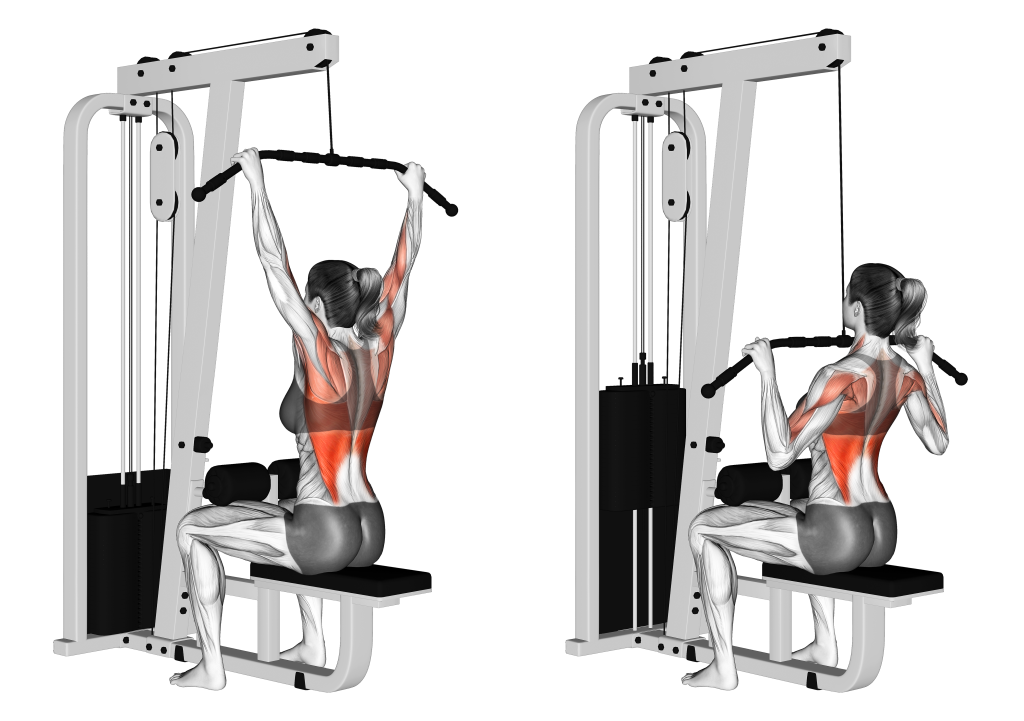
Once positioned correctly, the lifter will contract their lats and draw their elbows downwards, as if pinching an object with their shoulder blades. Avoid flaring the elbows out, as this can increase the risk of injury.
When the bar is below the lifter’s chin, they will slowly reverse the motion so as to complete the repetition.
4. The Neutral Grip Lat Pulldown
Just as there is a close and wide grip variation, the neutral grip lat pulldown instead places the wrists in a neutral orientation - emphasizing the brachialis and brachioradialis as well as creating a far safer exercise as a whole.
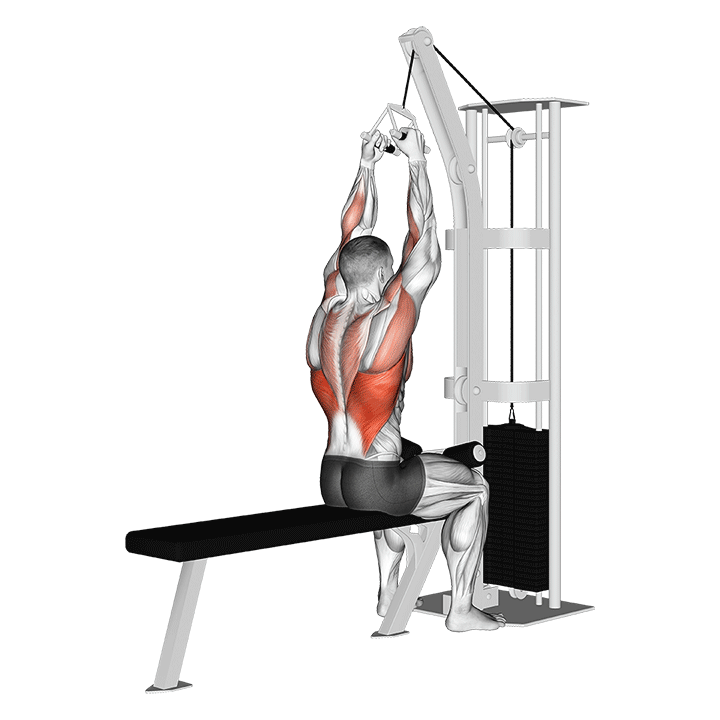
Neutral grip lat pulldowns are often preferred by individuals with shoulder or wrist issues relating to using a pronated or supinated grip.
That, or for those that wish to emphasize the lower trapezius and elbow flexor muscles by using a close neutral grip.
As a side note; neutral grip lat pulldowns require the use of a neutral grip cable attachment, rather than a straight bar. Depending on the desired grip width, this can either be the standard V handle or a straight bar neutral grip handle.
Back Muscles Worked
The neutral grip lat pulldown will emphasize the middle and lower trapezius alongside the brachioradialis and brachialis.
Ofcourse, like other kinds of pulldown, the biceps, posterior deltoids, latissimus dorsi and other middle back muscles will also be targeted.
Benefits as a Lat Pulldown Variation
The primary benefit to doing neutral grip pulldowns is its greater safety and lower impact on the joints of the upper body. This is especially true for individuals with poor shoulder girdle mobility or who have trouble with the pronated grip of traditional pulldowns.
Furthermore, lifters with insufficient muscular growth in their elbow flexors will find that the neutral grip pulldown may be the exact training stimulus they need to catch up.
How-to:
Performing a neutral grip lat pulldown is practically the same as doing so with the conventional variation, only with the elbows drawn closer to the sides and the wrists in a neutral orientation.
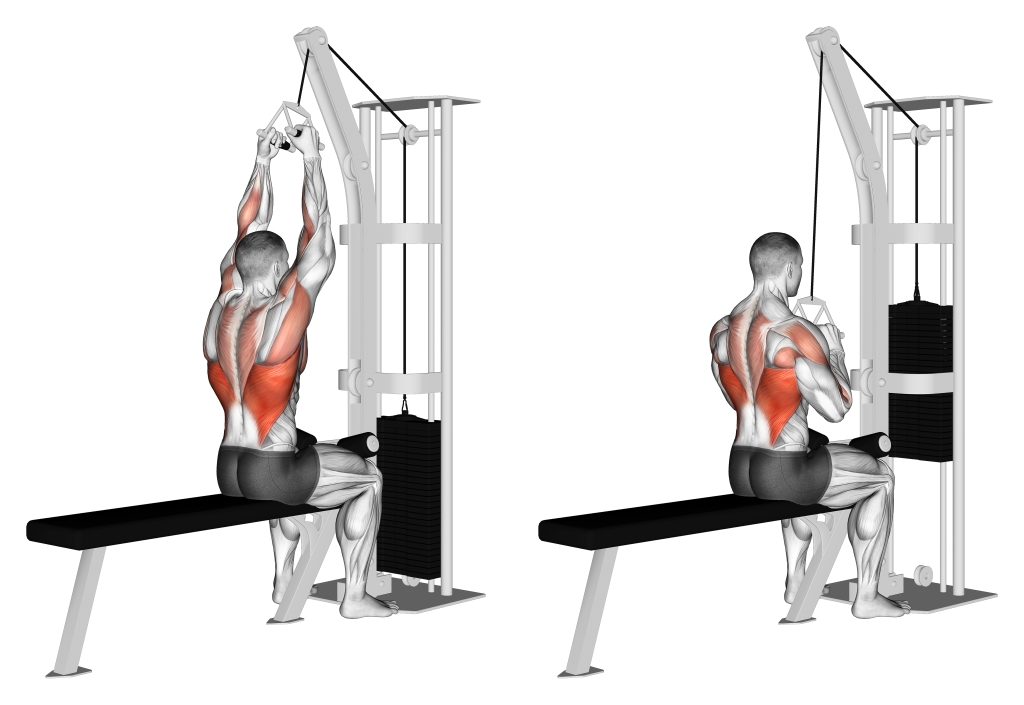
To perform the exercise, the lifter will seat themselves within the machine and grip the handles overhead with their palms facing each other. The elbows should be aligned beneath the hands with the torso upright and the scapula depressed.
From this stance, the lifter then draws their elbows downwards and backwards, drawing them parallel to the sides of the body as they pull the bar beneath to chin-level.
Once the bar is at the same depth as the chin, the lifter simply reverses the motion to complete the repetition.
5. The Underhand Lat Pulldown/Reverse Grip Lat Pulldown
The reverse grip lat pulldown is simply a conventional lat pulldown performed with an underhand grip. This not only increases the intensity to which the biceps are recruited, but also that of the forearm and chest muscles.
Underhand lat pulldowns will also feature a somewhat closer grip width, less elbow flaring and a more upright chest angle than other pulldown variants.
Because the reverse grip lat pulldown features a large change in muscular recruitment (in comparison to conventional pulldowns), some level of alteration in programming will be needed. Remember to account for total volume when including this exercise in your workout.
Back Muscles Worked
This particular pulldown variation will target the biceps brachii, forearms and chest alongside the usual muscles worked by pulldowns - meaning the lats, rhomboids, posterior deltoids and trapezius.
Benefits as a Lat Pulldown Variation
Apart from working the chest and arms to a far greater degree, the underhand pulldown also features a significantly shorter range of motion. This, combined with the greater number of muscles involved, means that lifters will be able to lift more weight than with other variants.
How-to:
To perform an underhand lat pulldown, the lifter will seat themselves within the lat pulldown machine, reaching up and gripping the bar around shoulder-width apart or narrower, hands supinated. The chest should be puffed out, with the scapula depressed and the torso leaning slightly backwards.
Now in the right stance, the lifter will simultaneously squeeze their shoulder blades and draw their elbows down to the sides of the torso. This should pull the bar beneath the lifter’s chin, with the elbows close to the ribs at the deepest portion of the movement.
Once the bar is sufficiently low, the lifter then slowly returns the bar back overhead - thereby completing the repetition.
6. The Standing Straight-Arm Lat Pushdown
Straight-arm lat pushdowns are a variation of lat pulldown where little to no elbow flexion is present, reducing the involvement of the elbow flexor muscles in exchange for the triceps brachii, chest, and greater lats recruitment.
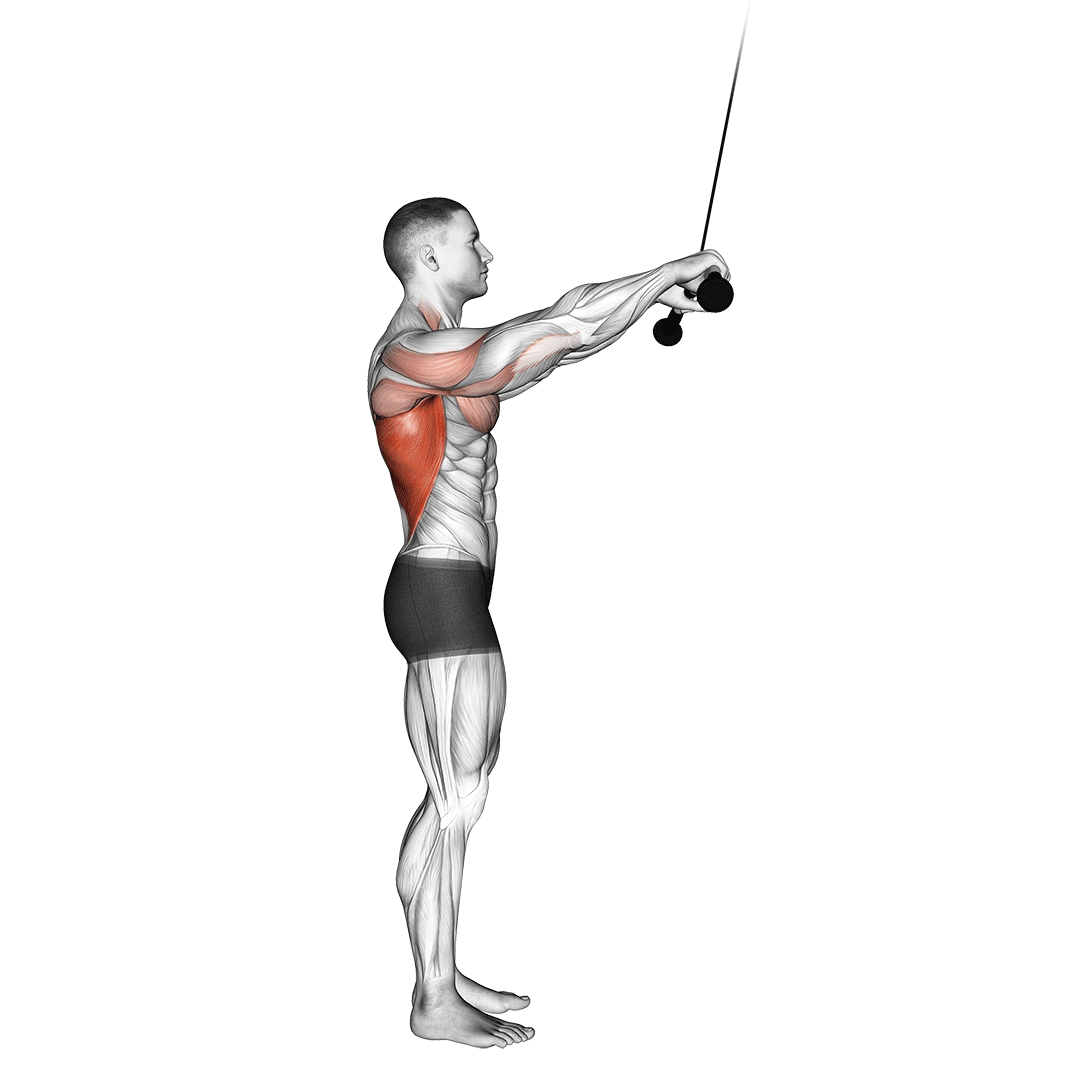
Because of the difference in range and mechanics, the straight-arm lat pushdown needs to be performed in a standing position.
This may be cumbersome with a conventional pulldown machine, and as such it is better to perform this exercise with a cable machine instead. In addition, foregoing a straight bar for a double rope attachment will help maximize range of motion.
Back Muscles Worked
The straight-arm lat pushdown will target the triceps brachii, the pectorals, the posterior deltoid head, the latissimus dorsi, the rotator cuff muscles and the rhomboids.
Benefits as a Lat Pulldown Variation
The straight-arm lat pushdown targets many muscles that are not otherwise worked by pulldown variations, exchanging the biceps, brachioradialis and brachialis for the chest and triceps.
While this may make the exercise somewhat more difficult to program, it is excellent for lifters who are limited by fatigue of the elbow flexors.
In addition, this variation can allow for somewhat more weight to be used, depending on the angle of the lifter’s torso. The more inclined the body, the more weight can be pushed downwards.
How-to:
To perform a repetition of the straight-arm lat pushdown, the lifter will stand upright facing a cable pulley set to a height over their head. A rope or bar attachment should be attached to it, held in a double overhand grip approximately shoulder-width apart.
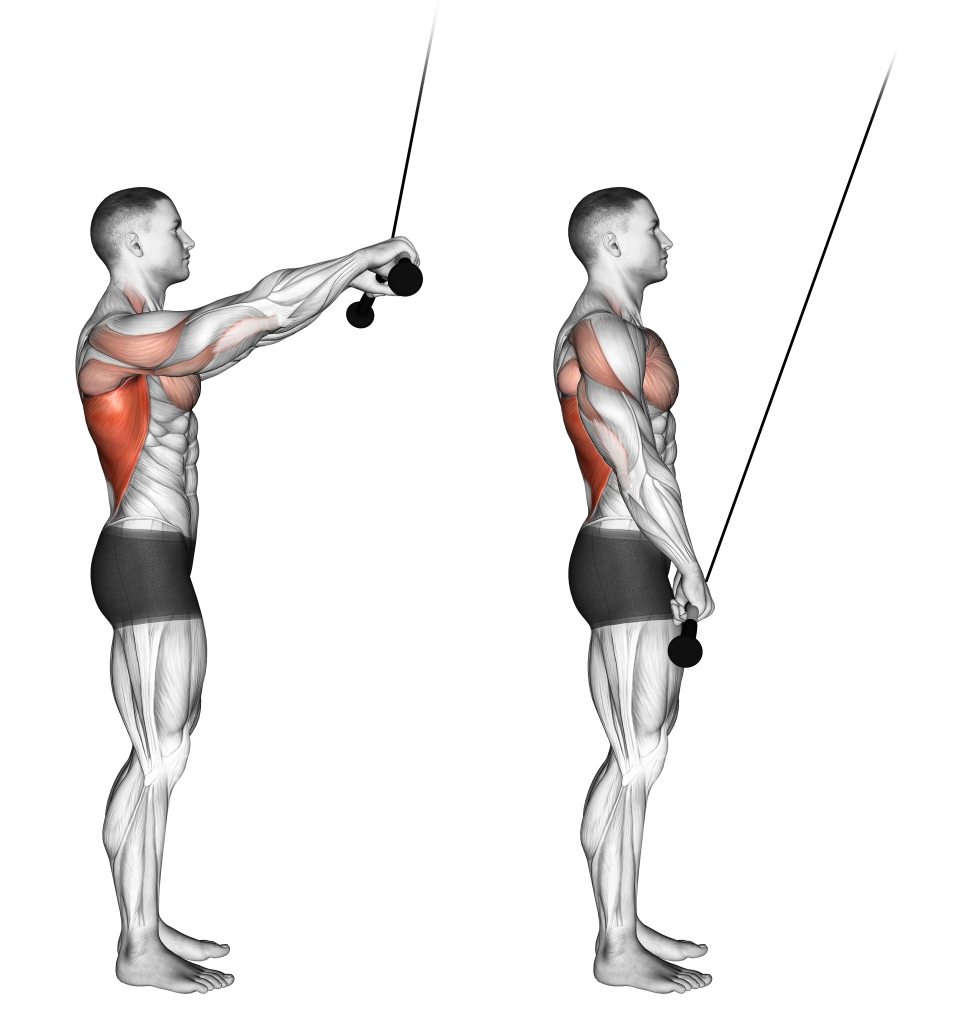
Then, bracing the core and adopting a balanced stance, the lifter will engage their lats and draw the bar from head-level towards their hips, preventing the scapula from winging as they do so.
Once the handle is near their waist or hips - and the hands are parallel to the sides - the lifter will allow the resistance of the cable to draw their hands back up. This completes the repetition.
7. An Honorable Mention: The Resistance Band Lat Pulldown
Incase you’re stuck at home or don’t want to use a cable machine, one variation of lat pulldown available is the resistance band pulldown.
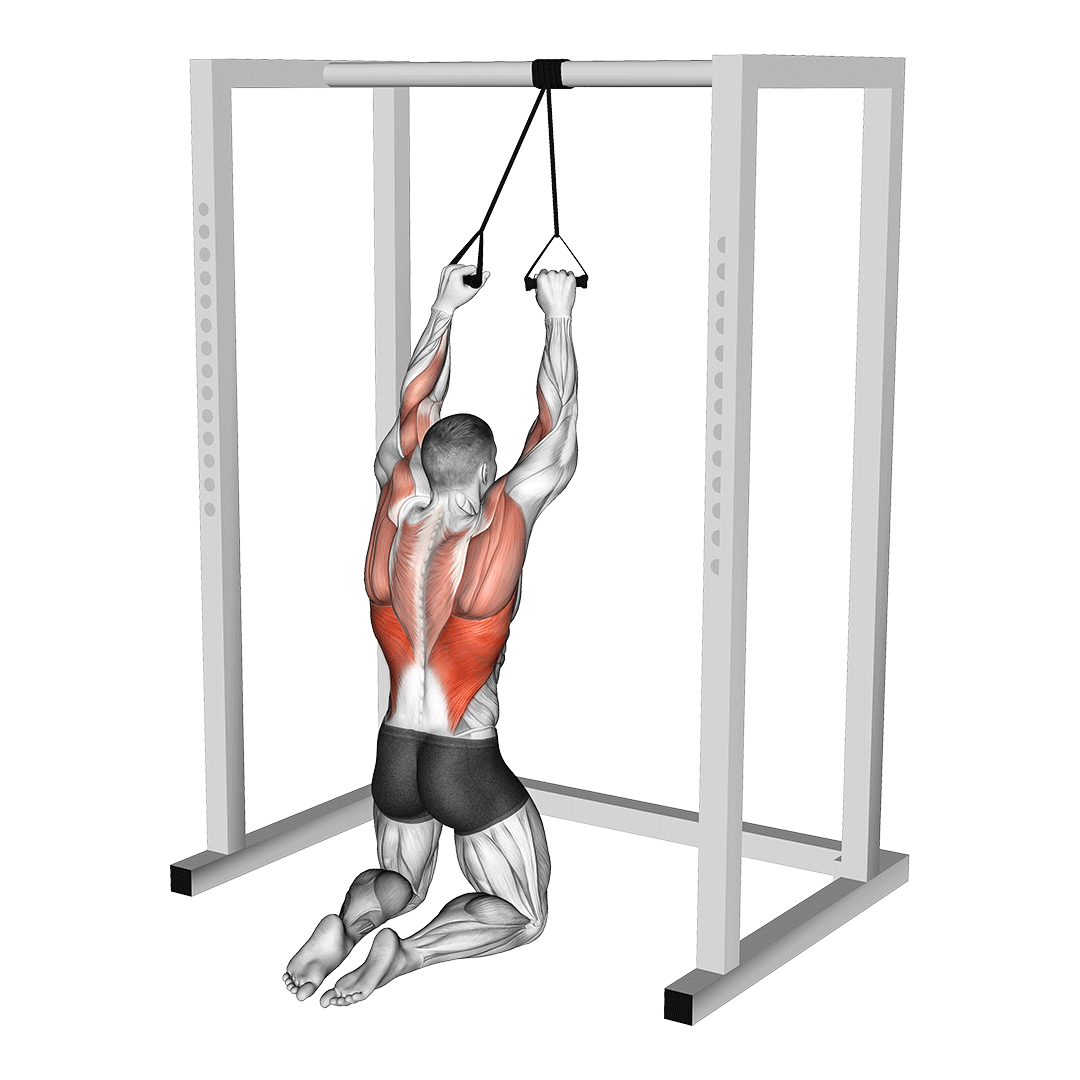
Much like other pulldown variants, the resistance band version is performed so as to target the muscles of the mid and upper back. Similarly, it also makes marked use of elbow flexion and scapular retraction.
However, unlike with a pulldown machine, the resistance band will often be angled diagonally away from the body with two separate ends to the band. This necessitates a more vertical torso angle, as well as a more neutral hand orientation.
Back Muscles Worked
The resistance band lat pulldown works much the same muscles as a conventional pulldown - meaning the latissimus dorsi, trapezius, rhomboids, teres muscles, infraspinatus and the elbow flexors.
However, depending on the type of resistance band and the grip orientation used, the brachioradialis and brachialis may play a more or less important role. Generally, a closer or neutral grip will cause greater recruitment of these muscles.
Benefits as a Lat Pulldown Variation
Apart from being plain convenient, the resistance band lat pulldown also allows for a somewhat freer range of motion as it is not limited by the shape of a bar or the angle of a pulldown machine.
How-to:
To perform a lat pulldown with the use of a resistance band, the center of the band should be wrapped around a stable anchor overhead. Both ends should be gripped in a neutral or pronated grip, with the lifter sitting facing the bands several feet away.
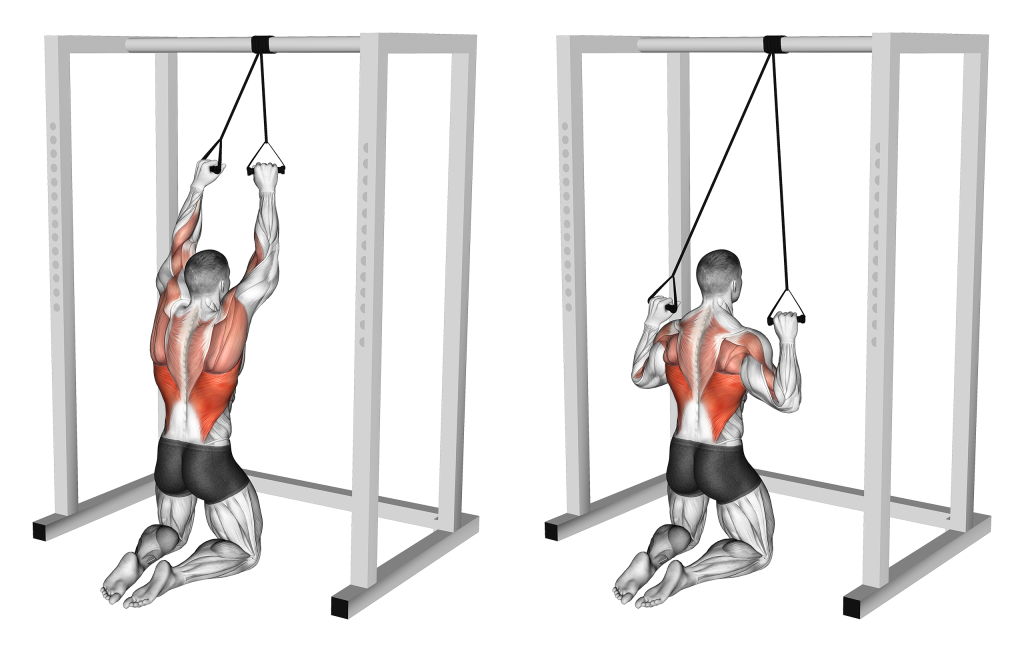
Keeping the chest upright and the scapula partially retracted, the lifter will then squeeze their lats and pull their elbows towards the sides of their torso. Pull in the opposite direction of the band, rather than straight backwards or downwards.
Once the elbows are parallel to the sides of the body, the lifter may reverse the movement in a slow and controlled manner to complete the repetition.
Which Lat Pulldown Should You Do?
With the sheer number of seemingly identical lat pulldown variations available, you may have trouble picking the right one.
Fortunately, it’s quite simple. Pick the variation that addresses the weakest part of your upper body - accounting for complexity and any history of injuries you may have.
For example; if your lats are not wide enough for your liking, pick a variation that specifically builds the outer lats, such as the wide grip lat pulldown. Alternatively, if your biceps and forearms are lacking, the reverse grip lat pulldown may be ideal.
It’s even possible to perform more than one variation within the same training session, if so needed. Just remember to keep the volume to a reasonable level and prioritize form above all.
References
1. Dos Remedios, Robert. Men's Health Power Training: Build Bigger, Stronger Muscles Through Performance-Based Conditioning. United States: Harmony/Rodale, 2007. ISBN: 9781605298689, 1605298689
2. Signorile, Joseph F et al. “A comparative electromyographical investigation of muscle utilization patterns using various hand positions during the lat pull-down.” Journal of strength and conditioning research vol. 16,4 (2002): 539-46.
3. Andersen, Vidar et al. “Effects of grip width on muscle strength and activation in the lat pull-down.” Journal of strength and conditioning research vol. 28,4 (2014): 1135-42. doi:10.1097/JSC.0000000000000232
